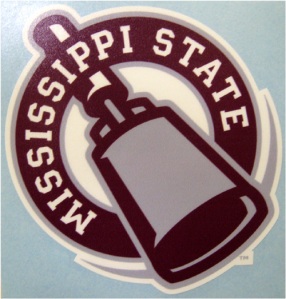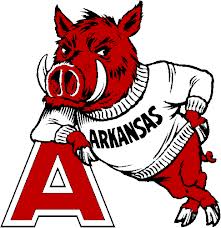Before I get to the main topic, I’ll mention a couple other things. Once again, please check out my LSU-Auburn Rivalry blog. I’m apprehensive another streak will come to an end. It’s much shorter than Mississippi St. was though: LSU has won three in a row and six of seven. Also, I had an observation about the computer ratings that I didn’t notice at first. Even though Nebraska is #3 right now, if you average it by playing week, the Huskers fall to 8th. So when Nebraska has a bye week on the 11th, they’ll have a more accurate rating after that point. Not that I expect they’ll have an easy time of things this weekend.
I’ll start with the good news from the LSU-NMSU game.
Brandon Harris obviously came in and did very well for the second week in a row. 11/14 for 178 yards, three touchdowns, no interceptions. He also had five rushes for 36 yards and two touchdowns. His yards per carry probably would have been better without the touchdown runs, but I like how he showed he can run into a guy bigger than him and keep going. I think Les Miles admires that ability more than anything, so hopefully Harris made a persuasive enough case to start the next game.
Other freshmen of note were RB Leonard Fournette, WR Malachi Dupre, and WR/PR Trey Quinn.
Not much to say about special teams, but just about all the kickoffs went through the endzone (and no miscues on extra points), and our punter had 147 yards in three kicks. We only allowed 7 yards in punt returns.
The defense was put under a lot of pressure with four turnovers and a three-and-out in the first quarter. Kendall Beckwith’s interception return for a TD (while a good thing) also added to pressure on the defense. They didn’t allow any points during that stretch (until the final minutes of the second quarter, which I’ll get to).
New Mexico St. did miss a 40-yard field-goal attempt in the first quarter, but that was when the Aggies had good field position after a turnover (and then a 15-yard penalty). They only obtained one first down in that drive.
I liked some of the different looks on offense. LSU HAS to be able to get the ball outside for short-yardage situations. When it’s a run and everyone knows it’s a run and they go up the middle, it’s not happening. It didn’t even happen against New Mexico St., which isn’t a good team in general and is especially bad against the run.
So even though the diamond formation resulted in a fumble, it wasn’t the fault of the formation, it was a good hit/bad holding onto the ball after the line of scrimmage. There was nothing wrong with the play itself. I would not be surprised if they at least tested it on Auburn once or twice.
There were also a couple of good (more conventional) option and pitchout plays that LSU understandably got away from with Mettenberger in the last couple of years, but why they weren’t there against Mississippi St. I have no idea. I think if LSU had just one of those plays and executed it (either for a touchdown or for the purpose of spreading out the field) during that goal-line stand, they would have won the game against the Bulldogs.
Three-and-outs are nice, but something else I like to see is a stop after giving up a first down or two. Against Wisconsin and Mississippi St. at times, it seemed like if they got that first first down, it was all over. I mentioned the missed field goal, but there were too additional stops at the LSU 47 in the first half while it was still only 14-0. The LSU offense had a three-and-out of its own between those two drives.
So there were a couple of situations that you don’t like to happen, but I like how they responded anyway.
Say what you will about the defense (although I noted they can catch the ball when you throw it to them and can also pick it up when it’s on the ground), New Mexico St. does have an offense that can produce points and yardage, so to keep them from even having scoring opportunities on all but two plays the whole game is good work.
There were some bad things, especially in the early going. It was another slow start on offense. Seven offensive points in the first quarter… no wonder they had zero for the first 20 minutes against Mississippi St. and only 7 for the first 2 ½ quarters against Wisconsin.
Of course, a big contributing factor to that was turnovers. You just can’t do that. In this case, you can’t give hope to the other team when they’re in a hostile environment with the odds stacked against them. Next week, when LSU is in that situation, it’s just asking to lose by 30 points or more if you start turning it over early. I’m not just talking about field position and points off of turnovers. Even if you don’t give the other team good field position, that means you had good field position yourself and squandered the field position and the momentum you were lucky to have.
I mentioned how LSU should try to spread out the field when they have the ball. If Cam Cameron would watch the LSU defense, maybe that would register in his mind a little more clearly. They gave up a play of almost 80 yards for a touchdown because they had too many people spread from sideline to sideline and no one had an angle after the runner went through the line of scrimmage. There were at least three similar plays between the Wisconsin and Mississippi St. games. A couple of them might have been short passes, but it was a similar issue with no one having any kind of angle on the ball-carrier. I know, one scoring play, but I think the Auburn offensive line might just be able to create more openings for plays of that nature.
New Mexico St. still had 274 yards (although it would have been fewer than 200 without the touchdown play), still completed more than almost half of its 33 passes, and still gained 4.6 yards per rush. That’s not as good as I was hoping for. The final score was great, but it does matter somewhat how you got there.
Also, third-down defense in the first half was not satisfactory. In two of the Aggies’ first three drives, they converted from 3rd and 6. There was another third-down conversion in the second quarter (from 1 yard) and nearly a fourth for the half before a fumble on that same down.
There is no excuse for LSU to have had five penalties in this game. They were only for 35 yards, but it creates similar types of issues to the turnovers I mentioned. I didn’t see the hands to the face. I saw the hand to the LSU player’s face on the same play, but there was some unnecessary sloppiness. Giving them a first and 5 toward midfield (for example) was not good.
I touched on this with the turnovers, but Jennings was bad. He ran himself (first drive only) and set up a couple of good running plays, but that was it. He only completed two passes for 11 yards, and none of the incompletions looked like good passes that I remember. One of the passes was for 7 yards and a first down, so it was really just one good passing play. Jennings threw two interceptions, was sacked once, and lost a fumble (on a separate play from the sack).
Conclusion
The hesitation with Harris was that he was liable to commit turnovers. Well, I think this should settle that (since I originally wrote this, Harris was named the starter). I know they want to give Jennings respect for his hard work as a backup and for practicing better and so forth, but next game will be game 6 of the season and most importantly game 2 of the SEC season.
I wish Jennings all the best and I hope he’s able to contribute to the team, but we’re past the time to be nice. He doesn’t need to start the next game, and I don’t think you even take Harris out unless he’s proven to be overall ineffective or mistake-prone in multiple possessions (or, God forbid, hurt). If Jennings can’t handle the pressure at home against New Mexico St., I don’t want to see him in the early going at Auburn. He’s a capable athlete, but I’m not comfortable with him at this point.
I want to say something about the boos. Someone said this about the NFL once: “We boo because we care.” If I’m in a stadium, especially paying an arm and a leg to be there, I’m going to voice my displeasure with certain coaching decisions. Everyone understands that when you want the coach to go for it and he sends out the punter, no one is booing the punter as a person. But somehow where quarterbacks are involved, people don’t seem to get it. There probably were some people who wanted to express displeasure to Jennings for the turnovers, but I believe the majority of the people were making clear that they didn’t like seeing the same guy come out and throw the same type of pass with the same result. The message wasn’t, “We don’t support you.”
I’m sure Auburn worked on improving some areas this week as well, so I’m still expecting it to be very difficult for LSU to win the game next week. I’ve been surprised by enough Les Miles teams in the past not to despair too much until the game is over and we have fewer points though. Or at least until we’re more than 20 points behind midway through the fourth quarter.
Also, no matter what happens, I don’t envy Auburn fans too much. Their next five games after LSU are Mississippi St., South Carolina, Ole Miss, Texas A&M, and Georgia. Every other one of those is on the road. I didn’t even mention the game in Tuscaloosa the Saturday after Thanksgiving.






















Alabama, Auburn, College Football, Florida St., LSU, Marshall, Michigan St., Mississippi St., Nebraska, Ohio St., Oklahoma, Oregon, TCU, Texas A&M, UCLA
Week 5 College Football Rankings 2014
In College Football, Rankings, Rankings Commentary on September 28, 2014 at 3:24 PMLSU plays Auburn this week, so if you’re interested, here is my LSU/Auburn Rivalry blog.
Rank/team/previous


1 Auburn 1
2 Florida St. 3
3 Alabama 5
4 Oregon 4
5 Oklahoma 2
6 Miss. St. 10
7 BYU 7
8 TX A&M 6
9 UCLA 16
10 Nebraska 23
11 Ole Miss 8
12 Notre Dame 12
13 Ga. Tech 17
14 LSU 13
15 Arizona 22
16 E. Carolina 14
17 Baylor —
18 Georgia 15
19 S. Carolina 9
20 Louisville —
21 Okie St. 20
22 NC State 24
23 TCU —
24 Marshall —
25 Missouri —
Full computer rankings 1-128 (as I will explain, these are not in agreement with the top 25 given above)
Out of rankings: (11) Penn St., (18) Rutgers, (19) Arkansas. (21) Washington, (25) Virginia
Explanation and future rankings
As I mentioned last week, this is my transition week into adopting all or most of my computer rankings.
I would have liked to have kept Arkansas, after its very good game against Texas A&M, and Virginia, which lost to two top-10 teams above and beat a top-20 team. I didn’t keep them because they were not in the top 35, and I didn’t want to deviate more than 10 spots.
The team where I deviated the most was East Carolina. I couldn’t justify putting them behind a Baylor team whose best win is Iowa St. Georgia has one win over an ACC team, but East Carolina has two.
South Carolina is the only two-loss team that made it, but the Gamecocks did so on the strength of their wins. Virginia’s just weren’t strong enough to merit consideration.
I don’t like ranking Missouri, but they have three wins over FBS teams. Obviously one of them is a very good win. I consider Indiana a bad loss, but it will take some time for them to show up that way even if the Hoosiers are in fact bad. Indiana is 2-2, including an FCS win; but the FCS team they beat is Indiana St., who is otherwise undefeated and has a win over an FBS team. So for right now it’s just sort of a mediocre loss. I do have Missouri a few spots below where the computer put them though.
I certainly didn’t want to put USC (the loss to Boston College isn’t looking so good) or Minnesota (who was destroyed by TCU) in the top 25 even though the computer had them there.
The only other team I was really reluctant to rank was Marshall, but they’re undefeated, and I couldn’t justify putting anyone else ahead of them.
I tried with Michigan St. and Ohio St., because I certainly think either would beat Marshall; but there just isn’t a good argument being that I’m trying to transition into the objective system. Michigan St. was the best available team; but they were 10 spots lower than Marshall, so there was really no way to justify bridging that gap. Ohio St. was even lower.
Michigan St.’s only wins are Jacksonville St., Eastern Michigan, and Wyoming, so I don’t think that’s good enough. At least Marshall beat Akron (who beat Pittsburgh). I know that isn’t much to go on, but it’s more than Michigan St. has; and again, the formula is something to go on as well.
It’s also more than Ohio St. has to go on. Navy and Cincinnati are just not looking like good wins right now. Cincinnati only beat Miami U. and Toledo, and Navy now has three losses after losing to Western Kentucky. Even if the Buckeyes do have better wins than Marshall does, that still doesn’t address the loss to Virginia Tech, whose only other wins are William and Mary and Western Michigan.
Cincinnati travels to U. Miami (the one in Florida) in a couple of weeks and also plays East Carolina in November, so if they win a string of games, that will help Ohio St. of course. Two byes and two wins over MAC teams (with two FBS wins between them) doesn’t help much right now though.
Ohio St. and Michigan St. both have decent opportunities to join the top 25 next week.
I moved the top 25 teams an average of four spots each. There are only four teams that I moved 7 or more spots up or down. I moved Arizona down 8, North Carolina St. down 7, East Carolina up 10, and Louisville up 7. I am trying to avoid any larger jumps next week.
Note that I still moved East Carolina down two spots compared to last week, I still moved Arizona up 7 spots as compared to last week, and I moved North Carolina St. up two spots as compared to last week despite a loss.
I want to go back to the teams I skipped over for a second, I’ll have no problem ranking USC if they beat Arizona St. next week and are still in the computer top 25. I just think they need that additional quality win in light of Boston College losing to Colorado St.
Minnesota has a bye week, so they’ll probably fall slightly on their own. If their past opponents are still good enough for them to stay in the top 25, I will probably still put them there. TCU plays Oklahoma, and Michigan travels to Rutgers, so we shall see. The Gophers are 22nd in the computer formula right now, so if they stay 22nd, that won’t bother me anyway.
I’m not 100% sure that next week won’t be another transition week, but I’m leaning toward going to the computers exclusively or almost exclusively (sometimes I slightly rearrange the very top teams in early October) next week. I take serious issue with a relatively small number of the results for this point in the season.
I predict I will stick to the computer rankings in full after the games of October 18. Alabama plays Texas A&M that day. Auburn is idle, but in the two weekends before their bye (i.e., this coming weekend and the following weekend) they play LSU and Mississippi St. Mississippi St. is idle the week of the 18th as well, but not before playing Texas A&M and Auburn. Florida St. plays Notre Dame on the 18th. Oregon plays UCLA on the 11th (which could also make or keep UCLA #1), followed by Washington on the 18th.
Nebraska plays Michigan St. this Saturday, but I doubt they can get enough points in the next three weeks under any combination of wins and losses by the other teams I mentioned. The Huskers are idle on the 11th and play Northwestern on the 18th.
Oklahoma is back at #10, but they have a decent combination of games in the next three weeks: TCU, Texas, and Kansas St.
Earlier rankings:
Preseason
Week 1
Week 2
Week 3
Week 4